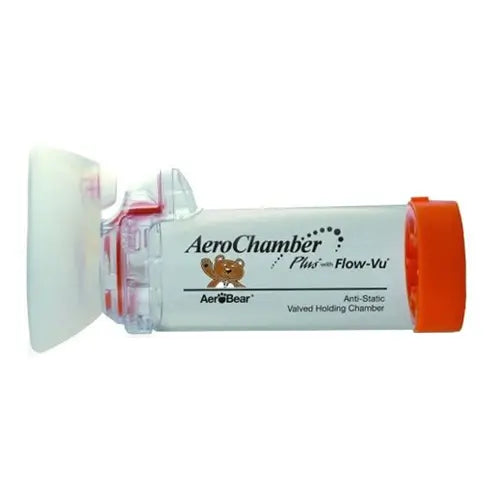Especially for babies from 0 to 18 months. It is used in the administration of medicines for the treatment of certain diseases such as asthma, bronchiolitis, otitis or acute laryngitis, where the route is inhaled.


The chamber allows the medication to stay longer to be inhaled. The mask is smaller to fit the size of the baby's face.
The Aerochamber is a plastic device that is placed between the mouth and the inhaler. Pressing the inhaler releases the medication into the inhalation chamber, after which the child can breathe calmly through the mask as there is no need for coordination between pulsation and inhalation.This is the main disadvantage of the use of pressurised inhalers, especially in babies and younger children.
The chamber is antistatic , which allows the medication to remain longer to be inhaled.
It has a built-in valve with Flow-Vu indicator , a small flap that moves every time the baby breathes, allowing you to count the breaths and check that we are using it correctly.
The mask guarantees a tight seal and is latex free , minimising the risk of allergies and a universal back piece that fits all inhalers on the market (universal adaptor).
The chambers are free of BPA, phthalates, latex, lead and PVC.
Inhalation chambers and pressurised aerosols are used in the administration of most medications for the treatment of certain diseases such as asthma , bronchiolitis , otitis or acute laryngitis , where the route of choice is the inhaled route.
The chamber allows high concentrations of drugs such as corticosteroids and bronchodilators to be achieved in the airways, thus achieving effects that could only be obtained with very high oral doses, with the consequent side effects.
For these drugs to be effective, parents must learn how to use the inhaler properly , because even if the technique used is correct, only a third of the medicine reaches the lungs , so if we do not know how to apply the inhaler properly, probably very little of the product will end up in the lungs.
- Remove the cap from the inhaler, put the inhaler in an upright (L-shaped) position and shake.
- Attach the inhaler to the opening of the chamber in an upright position and hold the chamber horizontally.
- Place the mask over the face so that the nose and mouth are covered. Make sure the mask is tight against the face, but do not cover the infant's eyes with the mask.
- Tilt the infant's head back slightly.
- Squeeze the inhaler and fire a single dose. Keep the chamber tilted slightly upwards.
- Let the infant breathe in about 10 times, the Flow-Vu valve should move up and down each time the infant breathes. Move the mask away from the baby's face.
- If the paediatrician has prescribed a second dose, wait 30 seconds to a minute and shake the inhaler again, so repeat the whole process from the beginning.
- Wash the baby's face to remove the residue of the medicine and avoid irritating the skin.
- It is advisable to clean the baby's mouth. In infants, it is enough to offer them a little water or breast milk. If they are old enough to use a toothbrush, it is better, otherwise a damp gauze swab inside the mouth is sufficient.
- The inhalation chamber should be cleaned frequently to remove drug deposits on the walls, which can cause the system to become ineffective.
- It is recommended that the chamber be cleaned once a week. Frequent cleaning will prevent drug build-up inside the chamber.
- It is not necessary to clean it before the first use.
- Remove only the back side. Do not remove the mask or valve assembly. Place both parts in a mild solution of liquid dish detergent and warm water for 15 minutes. Shake gently and rinse the parts in clean water. Shake to remove excess water from the parts and allow to dry in an upright position.
- Air dry all parts on a clean cloth (Do not rub to dry).
- The Aerochamber can also be cleaned in the dishwasher.
- It is important not to store the chamber parts until they are completely dry, to prevent the growth of bacteria and germs.
- Valves should be checked and the chamber discarded if there are cracks.
- As time goes on, the valve cover may harden and curl. If this happens, replace the AeroChamber.
It is important to clean the mouth after inhaler use because it increases the risk of tooth decay , as residual dust can remain in the mouth for a long time.
In infants it is sufficient to offer a little water or breast milk. If the baby rejects it at that moment, we will wipe the inside of the mouth with a moistened gauze.
From the age of two, in addition to offering them water to rinse their mouth, parents should make sure that they brush their teeth. They will brush without toothpaste or with a fluoride-free toothpaste.
Children aged 5-6 years can start using fluoride toothpaste when they know how to rinse properly without swallowing it.
Children with chronic respiratory problems such as asthma, due to prolonged use of inhalers, have a lower saliva production (26% less) and a decrease in the pH of the saliva, resulting in a greater acid attack on the teeth. A non-cariogenic diet and a good brushing technique are necessary in order to avoid damage to their dental system.